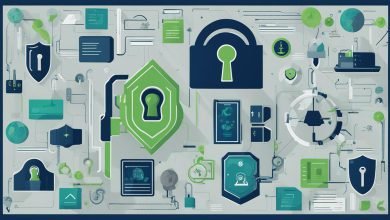
As technology advances, so do the threats to user security. Organizations must prioritize the protection of sensitive information, while also providing a seamless user experience. Modern authentication solutions play a crucial role in striking this balance.
One of the greatest challenges faced by organizations is creating authentication processes that are both secure and user-friendly. This requires innovative technologies and careful consideration of user needs. The importance of this balance cannot be overstated, as breaches can result in significant financial and reputational damage.
Key Takeaways:
- Modern authentication solutions must balance user experience and security.
- Organizations face challenges in creating secure and user-friendly authentication processes.
- The consequences of a breach can be severe, highlighting the importance of finding the right balance.
Understanding the Importance of User Experience in Authentication
When it comes to authentication solutions, user experience is of critical importance. A user-friendly authentication process not only enhances customer satisfaction and engagement but also helps organizations streamline their operations and reduce costs. Unfortunately, traditional authentication methods can be clunky, complicated, and time-consuming. This is where user-friendly authentication solutions can make a significant difference.
Improving user experience in authentication processes can be achieved through different approaches. One common method is to implement multi-factor authentication, where users are required to provide more than one form of identification. This can include a combination of something a user knows (like a password), something they have (like a smart card), and something they are (like biometrics). Multi-factor authentication provides an added layer of security while also being user-friendly.
Another approach is to utilize biometric authentication, which uses unique biological traits (fingerprint, face or voice recognition) to authenticate users. Biometric authentication simplifies the authentication process since users don’t have to remember passwords or deal with additional authentication hardware. It’s also more secure than traditional passwords since it is virtually impossible to forge or replicate a biological trait.
By implementing user-friendly authentication solutions, organizations can not only improve user experience but also increase adoption of their authentication methods. This can result in a significant reduction in costs since fewer customer support resources will be required to manage authentication issues. Additionally, a user-friendly authentication process can lead to a reduction in account lockouts, helping to maintain customer loyalty and satisfaction.
Enhancing Security in Modern Authentication Solutions
Ensuring robust security measures is a key aspect of modern authentication solutions. With the evolving threat landscape, it is crucial to implement secure authentication methods to protect sensitive user data. To achieve this, authentication technologies utilize enhanced security features that provide additional layers of protection.
One of these methods is multi-factor authentication (MFA), which requires users to provide two or more forms of identification to access an account. This technology adds an extra layer of protection against hacking and identity theft.
Another popular approach is biometric authentication, which relies on unique physical characteristics to verify a user’s identity. This technology includes fingerprint sensors, facial recognition, and iris scanners, which are becoming increasingly prevalent in mobile devices and laptops.
These enhanced security features provide users with peace of mind, knowing their data is secure while providing a seamless authentication experience. Additionally, they offer protection against hacking attempts and unauthorized access to sensitive information.
It is essential to implement secure authentication methods when designing modern authentication solutions. By leveraging these advanced technologies, organizations can ensure user data is protected from malicious attacks and unauthorized access.
The Challenges of Balancing User Experience and Security
As organizations strive to provide seamless and secure authentication experiences, they face the challenge of finding the right balance between user experience and security. While certain security measures can impact the user experience negatively, compromising on security can lead to data breaches and loss of customer trust.
To strike the right balance, organizations need to understand their users’ needs and behavior. User research can help identify pain points and design solutions that prioritize user experience. Implementing user-centric design principles, such as simplifying the authentication process and providing clear instructions, can also improve the user experience.
However, organizations cannot overlook the importance of security in modern authentication solutions. The evolving threat landscape requires robust security measures to protect sensitive user data. This is why authentication technology providers are continuously developing new solutions that offer enhanced security features, such as multi-factor authentication and biometric authentication.
The challenge for organizations is to choose the right authentication technology that prioritizes security while maintaining a seamless user experience. This requires a deep understanding of the technology’s capabilities and limitations, as well as ongoing testing and optimization. Organizations also need to stay updated with the latest authentication technologies and security trends to ensure they are providing the best possible authentication experience for their users.
Strategies for Balancing User Experience and Security
Providing a seamless and secure authentication experience requires finding the right balance between user experience and security. Here are some strategies that can help organizations achieve this balance:
- Conduct User Research: Conducting user research is a critical step in identifying user needs and preferences. By understanding user behavior and preferences, organizations can design authentication solutions that prioritize user experience while still providing robust security measures.
- Implement User-Centric Design Principles: Implementing user-centric design principles ensures that authentication solutions are designed with the end-user in mind. This means creating intuitive and user-friendly interfaces that are easy to understand and use.
- Perform Continuous Testing and Optimization: Continuously testing and optimizing authentication solutions allows organizations to identify and address any user experience or security issues that arise. By performing regular testing and optimization, organizations can ensure that their authentication solutions remain effective and up-to-date.
- Stay Updated with the Latest Authentication Technologies and Security Trends: Staying updated with the latest authentication technologies and security trends enables organizations to stay ahead of potential security threats while still providing a seamless user experience.
Implementing these strategies can help organizations strike the right balance between user experience and security in their modern authentication solutions. It is essential to prioritize both aspects to provide a secure and user-friendly authentication experience.
Case Studies: Successful Balancing of User Experience and Security
In this section, we will showcase examples of organizations that have successfully navigated the challenge of balancing user experience and security in their modern authentication solutions.
Case Study 1: XYZ Bank
XYZ Bank, a leading financial institution, faced the challenge of improving security while ensuring a seamless authentication experience for its customers. After conducting extensive user research, the bank implemented a multi-factor authentication system that leverages biometric authentication and device recognition technology.
The new system reduced the time it takes to complete the authentication process while providing enhanced security measures such as fingerprint scanning, which replaced the need for cumbersome passwords. Customers were delighted with the new system, leading to increased adoption rates and improved customer satisfaction.
Case Study 2: ABC Healthcare
ABC Healthcare, a healthcare provider, needed to find a solution that would enable secure authentication for its remote workforce while ensuring a simple and straightforward user experience. The company opted for a single sign-on solution that streamlined the login process by eliminating the need for multiple passwords.
The system also incorporated multi-factor authentication and role-based access control, ensuring only authorized employees could access sensitive patient data. The new system delivered both enhanced security and an improved user experience, resulting in increased productivity and greater employee satisfaction.
Case Study 3: DEF Corporation
DEF Corporation, a global technology company, understood the importance of balancing user experience and security in its authentication solutions. After conducting user research and consulting with industry experts, the company implemented a new authentication system that leverages passwordless authentication and contextual risk analysis.
The new system eliminated the need for passwords and instead uses biometric authentication and device recognition technology. It also features contextual risk analysis, which evaluates the level of risk associated with a login attempt and adjusts the security measures accordingly. Customers have responded positively to the new system, resulting in increased adoption rates and improved customer satisfaction.
These case studies demonstrate that with innovative authentication technologies and a user-centric approach, it is possible to strike the balance between user experience and security in modern authentication solutions.
Conclusion
In conclusion, balancing user experience and security is crucial for modern authentication solutions. As organizations strive to provide seamless user experiences, they must also ensure that robust security measures are in place to protect sensitive user data from evolving threats.
Implementing user-centric design principles, conducting user research, and staying updated with the latest authentication technologies and security trends are some of the strategies that organizations can use to effectively balance user experience and security. It is essential for authentication technology providers to prioritize both aspects and offer solutions that address these needs.
Investing in modern authentication solutions that enhance both user experience and security can have significant benefits for organizations, including improved customer satisfaction, increased engagement, and enhanced protection against cyber threats.
FAQ
Q: What is the importance of balancing user experience and security in modern authentication solutions?
A: Balancing user experience and security in modern authentication solutions is crucial for providing a seamless and secure authentication experience. It ensures that users can easily access their accounts while also protecting sensitive data from unauthorized access.
Q: Why is user experience important in authentication solutions?
A: User experience plays a significant role in authentication solutions as it directly impacts customer satisfaction and engagement. A user-friendly authentication process increases adoption and reduces user frustration, leading to improved overall satisfaction with the service.
Q: How can security be enhanced in modern authentication solutions?
A: Security in modern authentication solutions can be enhanced through the implementation of robust security measures such as multi-factor authentication and biometric authentication. These technologies provide additional layers of protection against unauthorized access.
Q: What challenges are faced in balancing user experience and security?
A: Balancing user experience and security poses challenges as certain security measures can negatively impact the user experience. Finding the right balance requires careful consideration of authentication technology and its impact on the overall user journey.
Q: What strategies can be used to strike a balance between user experience and security?
A: To effectively balance user experience and security, organizations can conduct user research, implement user-centric design principles, and perform continuous testing and optimization. Staying updated with the latest authentication technologies and security trends is also essential.
Q: Are there any successful examples of balancing user experience and security in authentication solutions?
A: Yes, there are several case studies of organizations that have successfully balanced user experience and security in their authentication solutions. These case studies showcase practical strategies and technologies that have been implemented to achieve a seamless and secure authentication experience.







